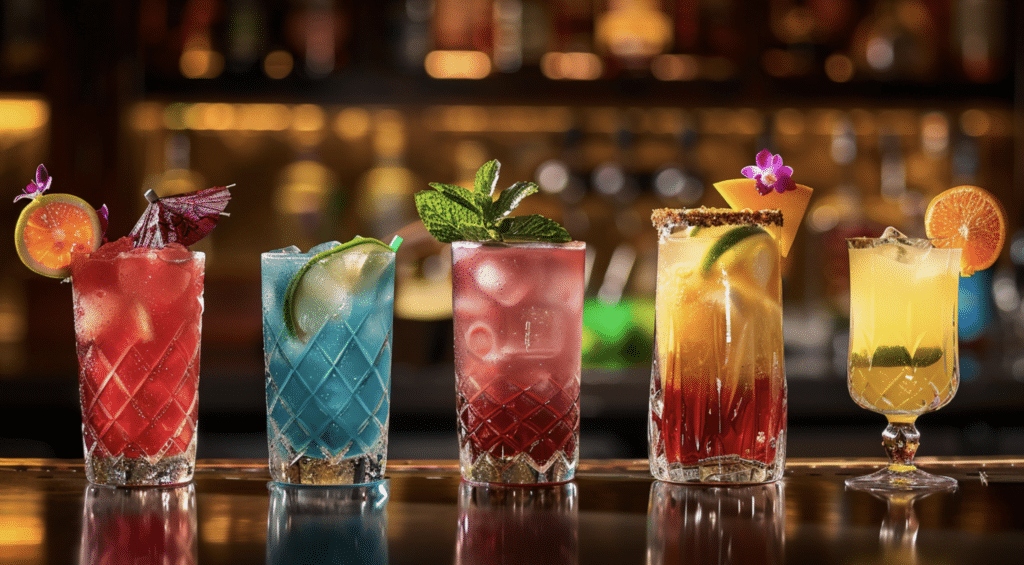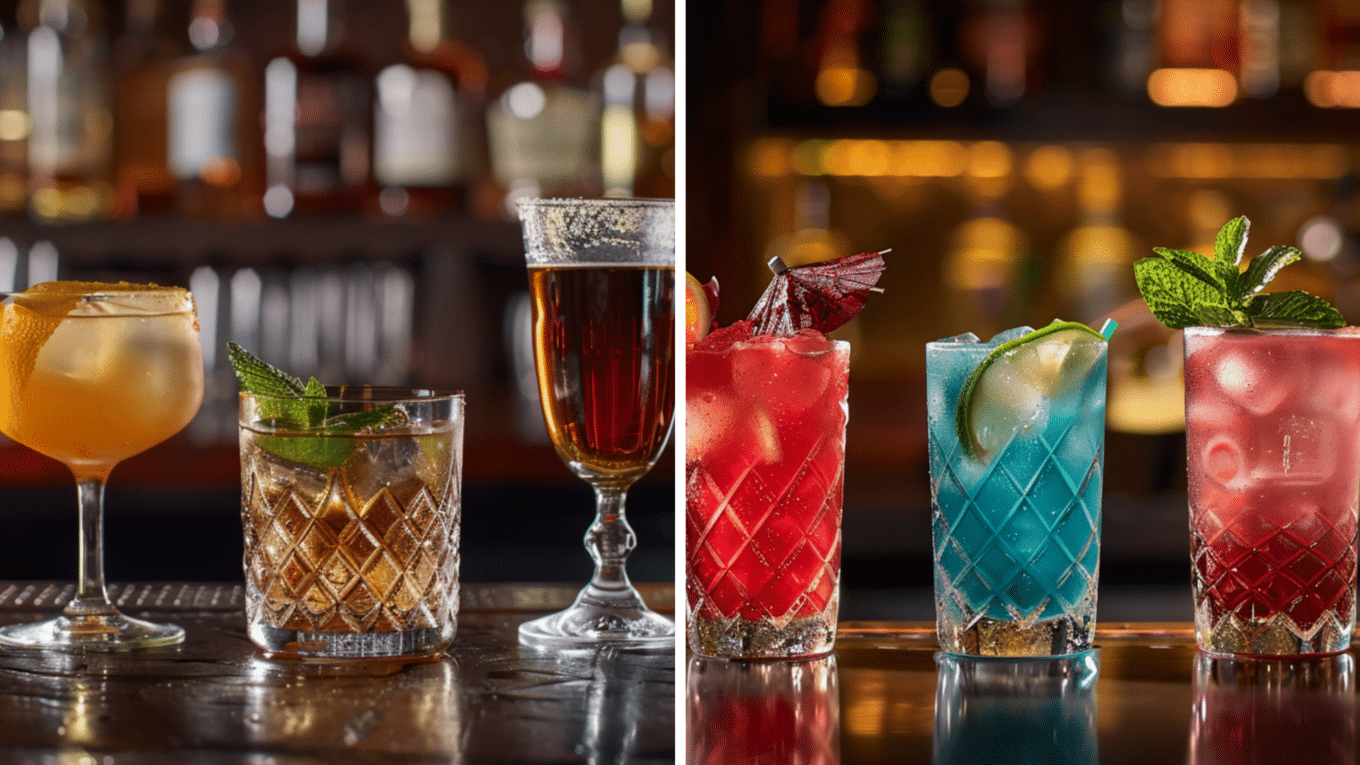Are you curious about the rising popularity of mocktails and how they compare to traditional cocktails?
Many people are surprised to learn that these non-alcoholic drinks offer more than just a refreshing alternative.
Mocktails and cocktails may seem similar at first glance, but they have distinct differences that set them apart.
Understanding these key differences can help you choose the perfect drink for any occasion.
Whether you’re looking to enjoy a delicious beverage without alcohol or want to explore mocktails’ unique flavors and benefits, this article will provide valuable insights.
Keep reading to discover the perks of mocktails, how they differ from cocktails, and why they’re becoming a popular choice for people of all ages.
Key Features of Cocktails

Cocktails are alcoholic drinks that typically combine spirits, mixers, and other flavorings.
The term “cocktail” can be traced back to the early 1800s.
The first known definition appeared in The Balance and Columbian Repository in 1806, describing it as “a stimulating liquor, composed of spirits of any kind, sugar, water, and bitters.”
Over time, cocktails have evolved to include various ingredients and techniques, from the classic martini to modern craft cocktails.
The use of spirits in cocktails can add depth and complexity to the flavor profile.
1. Cultural and Social Implications of Cocktails
Cocktails have been perceived as sophisticated adult beverages, often associated with luxury, glamour, and social status.
Iconic cocktails like the martini, Manhattan, and Old Fashioned have become synonymous with certain eras, lifestyles, and movie scenes, shaping social norms and expectations.
Cocktails are seen as a way to unwind, celebrate, or indulge, while others may view them as unnecessary or harmful.
2. Preparation and Artistry of Cocktails
Mixologists and bartenders employ various techniques to balance flavors, textures, and visual appeal in cocktail creations.
Cocktail preparation often involves complex mixing techniques, such as shaking, stirring, muddling, and layering.
Using bitters, infusions, and garnishes adds depth and complexity to the flavor profile while choosing glassware and ice can impact the overall experience.
Skilled bartenders understand how to balance a drink’s sweet, sour, and strong elements to create a harmonious and enjoyable cocktail.
A good cocktail example is a traditional mojito, which combines white rum, lime juice, sugar, mint leaves, and soda water.
The mint is gently muddled to release its oils, and the drink is served over ice.
3. Economic and Market Trends of Cocktails
The craft cocktail movement has played a significant role in revitalizing the cocktail industry.
This trend emphasizes using high-quality, artisanal ingredients and redefining classic recipes with a modern twist.
Craft cocktail bars and speakeasies have gained popularity, offering patrons unique and memorable drinking experiences.
Bartenders are increasingly seen as skilled artisans, crafting personalized and innovative cocktails to cater to discerning tastes.
Global trends, such as experiential dining and premiumization, have also contributed to the popularity of cocktails.
Consumers are willing to pay more for high-quality, handcrafted drinks that offer a multi-sensory experience.
The demand for premium spirits and unique flavor combinations has driven the growth of the cocktail market, with many restaurants and bars now offering signature cocktail menus to attract customers.
Key Features of Mocktails

Mocktails are non-alcoholic alternatives designed to mimic the taste and presentation of cocktails without the alcohol content.
Mocktails are a more recent invention, gaining popularity to offer the cocktail experience to those who choose not to consume alcohol.
These drinks often combine fruit juices, syrups, and herbs to create complex flavors and visually appealing presentations.
As the demand for non-alcoholic options grows, mocktails have become increasingly sophisticated, with many bars and restaurants offering creative and delicious alcohol-free alternatives.
Mocktails rely on the careful balance of non-alcoholic ingredients to achieve a satisfying taste.
1. Cultural and Social Implications of Mocktails
Mocktails have gained popularity as inclusive alternatives that allow everyone to participate in the social aspects of drinking without consuming alcohol.
The rise of the “sober curious” movement and increased awareness of health and wellness have contributed to the growing demand for non-alcoholic options.
Mocktails provide a way for people to socialize and enjoy the atmosphere of bars and events without the potential negative consequences of alcohol consumption.
Mocktails cater to diverse social needs, from designated drivers to those who abstain from alcohol for personal, religious, or health reasons.
The availability of high-quality mocktails allows non-drinkers to feel included and enjoy the social experience without compromising their preferences or values.
2. Preparation and Artistry of Mocktails
Mocktail preparation requires a similar level of creativity and attention to detail, as mixologists strive to replicate the complexity of cocktails using non-alcoholic ingredients.
This often involves experimenting with different flavor combinations, textures, and presentation styles to create drinks that are just as appealing as their alcoholic counterparts.
Using fresh fruits, herbs, and spices can add depth and nuance to mocktails, while techniques like smoking, foaming, and layering can enhance the visual impact.
The most common mocktail is the virgin mojito, which combines lime juice, sugar syrup, mint, and soda water.
A splash of non-alcoholic rum substitutes can be added for a more authentic taste.
3. Economic and Market Trends of Mocktails
The growing health and wellness trend has significantly driven the mocktail market.
As consumers become more health-conscious, the demand for non-alcoholic alternatives has increased.
People seek low-sugar, low-calorie, and nutrient-rich beverages that align with healthy lifestyles.
With their focus on fresh ingredients and creative flavor combinations, mocktails have become an attractive option for health-minded individuals.
The mocktail market has also seen an expansion in offerings, with the emergence of non-alcoholic spirits, ready-to-drink mocktails, and alcohol-free bars.
These products and establishments cater to a growing segment of consumers who want to enjoy the social and sensory experience of drinking without the negative effects of alcohol.
As the demand for non-alcoholic options continues to rise, the mocktail market is expected to innovate and grow, providing a wider range of choices for health-conscious consumers.
Benefits of Drinking Cocktails
1. Sensory Experience
One of the primary appeals of cocktails is the opportunity to savor traditional flavors and experience the complex taste profiles created by skilled mixologists.
The combination of spirits, mixers, and garnishes can result in a delightful sensory experience that can be both psychologically uplifting and culturally enriching.
2. Cultural Heritage
Many classic cocktails have fascinating origin stories and have significantly shaped social norms and cultural traditions.
By enjoying a well-crafted cocktail, individuals can connect with this heritage and appreciate the artistry behind the drink.
This cultural aspect of cocktails can enhance the overall drinking experience and provide a sense of sophistication and refinement.
Benefits of Drinking Mocktails
1. Inclusivity
One of the key benefits of mocktails is their ability to make social environments more accessible and inclusive.
By providing appealing non-alcoholic options, mocktails ensure everyone can participate in the social experience, regardless of their drinking preferences or limitations.
This inclusivity is particularly important for those who cannot or choose not to drink alcohol, such as designated drivers, pregnant women, or individuals with religious or personal reasons for abstaining.
2. Healthier Choice
Mocktails also offer a healthier alternative to alcoholic beverages.
As they are typically lower in calories and free from alcohol, mocktails can be a better choice for those looking to maintain a balanced diet or manage their weight.
Additionally, mocktails often incorporate fresh fruits, herbs, and other nutritious ingredients, providing a tasty way to consume vitamins and antioxidants.
Summing It Up
Understanding the key differences and perks of mocktails and cocktails empowers you to make informed choices that align with your lifestyle and preferences.
Whether you opt for the refreshing and inclusive appeal of mocktails or the rich heritage and complex flavors of cocktails, both options offer unique benefits.
As the market continues to evolve, driven by health-conscious consumers and the craft cocktail movement, the possibilities for enjoying delightful beverages are endless.
So, the next time you’re at a social gathering or want to unwind, consider exploring the diverse world of mocktails and cocktails.
Embrace the opportunity to experiment with new flavors, connect with others, and raise a glass to the art of mixology.
Cheers to finding your perfect drink, whether shaken, stirred, or alcohol-free!




